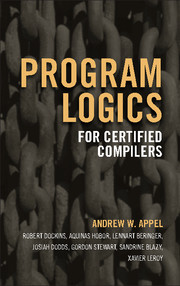Book contents
- Frontmatter
- Dedication
- Contents
- Road map
- Acknowledgments
- 1 Introduction
- I Generic separation logic
- II Higher order separation logic
- III Separation logic for CompCert
- IV Operational semantics of CompCert
- 31 CompCert
- 32 The CompCert memory model
- 33 How to specify a compiler
- 34 C light operational semantics
- V Higher-order semantic models
- VI Semantic model and soundness of Verifiable C
- VII Applications
- Bibliography
- Index
32 - The CompCert memory model
from IV - Operational semantics of CompCert
Published online by Cambridge University Press: 05 August 2014
- Frontmatter
- Dedication
- Contents
- Road map
- Acknowledgments
- 1 Introduction
- I Generic separation logic
- II Higher order separation logic
- III Separation logic for CompCert
- IV Operational semantics of CompCert
- 31 CompCert
- 32 The CompCert memory model
- 33 How to specify a compiler
- 34 C light operational semantics
- V Higher-order semantic models
- VI Semantic model and soundness of Verifiable C
- VII Applications
- Bibliography
- Index
Summary
The imperative programming paradigm views programs as sequences of commands that update a memory state. A memory model specifies memory states and operations such as reads and writes. Such a memory model is a prerequisite to giving formal semantics to imperative programming languages, verifying properties of programs, and proving the correctness of program transformations.
For high-level, type-safe languages such as ML or the sequential fragment of Java, the memory model is simple and amounts to a finite map from abstract memory locations to the values they contain. At the other end of the complexity spectrum, we find memory models for shared-memory concurrent programs with data races and relaxed (non sequentially consistent) memory, where much effort is needed to capture the relaxations (e.g. reorderings of reads and writes) that are allowed and those that are guaranteed never to happen [1].
For CompCert we focus on memory models for the C language and for compiler intermediate languages, in the sequential case and with extensions to data race-free concurrency. C and our intermediate languages feature both low-level aspects such as pointers, pointer arithmetic, and nested objects, and high-level aspects such as separation and freshness guarantees. For instance, pointer arithmetic can result in aliasing or partial overlap between the memory areas referenced by two pointers; yet, it is guaranteed that the memory areas corresponding to two distinct variables or two successive calls to malloc are disjoint.
- Type
- Chapter
- Information
- Program Logics for Certified Compilers , pp. 237 - 271Publisher: Cambridge University PressPrint publication year: 2014



